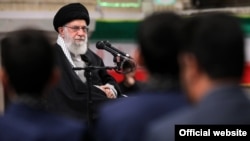Iran's hardliner dominated constitutional watchdog that vets election candidates, disqualified most of the reformists for the February 21 parliamentary elections, with the direct support of Supreme Leader Ali Khamenei.
The widespread disqualification of reformist candidates came while political activists in Iran thought Khamenei would succumb to allowing some diversity in order to cope with the rising tensions in Iran's domestic politics and foreign policy. But this analysis turned out to be wrong.
Events proved that there was a will to create a totally conservative parliament in maximum accord with Khamenei's policies. Prominent politicians such as current MPs Ali Motahari and Mahmoud Sadeqi who occasionally criticized the party line and some institutions close to Khamenei have been disqualified.
This can be a prelude to returning to Khamenei's absolute rule, in the same way that it existed in the aftermath of the 2009 Presidential election. At the time, there was alike-minded president, the ultraconservative Mahmoud Ahmadinejad, and a hardliner parliament (Majles) who were blindly at the service f Khamenei, at least up to a certain point.
Between 2008 and 2011 Ahmadinejad was totally obedient to Khamenei and opposition at the Majles was minimal. Chairman Akbar Hashemi-Rafsanjani was kicked out of the Assembly of Experts and the Expediency Council was manipulated in a way to limit Rafsanjani's power and give the upper hand to Khamenei supporters. In the meantime, the other pillars of power were also at the service of the Supreme Leader and any opposition was suppressed.
The outcome of Khamenei's absolute rule at that time led to one of the widest political divides in post-revolution Iran that was manifested in the post-election unrest in 2009, which led to Iran's total isolation in international community, widespread social and security crises and a harsh crackdown on the opposition.
However, these crises as well as serious domestic and international pressures and the fear of the regime's collapse prompted Khamenei to step back and offer limited concessions to domestic and foreign critics, which culminated in his submission to negotiations with the United States and the resulting nuclear agreement with the West; the Joint Comprehensive Plan of Action (JCPOA).
Regardless of such a complicated and costly experience, it appears that Khamenei is once again craving for a return to his absolute rule.
The widespread disqualification of Majles election candidates, grooming younger political figures affiliated with the institutions under Khamenei's direct supervision, his allusion to electing "a devoted revolutionary young man" as the country's next President, limiting the remaining authority of the Majles by giving prominence to the Expediency Council, and opposition to any negotiation and change in the country's foreign policy are among the signs that can lead to what Khamenei has earlier described as the "second step" of the Islamic Revolution.
One of the objectives of this second step is likely to be the consolidation of the structure of the Islamic Republic to ensure a safe transition to the post-Khamenei period in the coming years.
This consolidation of political structure may take place by unifying the body of the regime's institutions and even changing its master structure from a presidential system to a parliamentary system.
This could also signify Khamenei's opportunism. He assesses the experience of negotiating with the West as a failure. Now that the Rouhani administration as the advocate of that idea has been isolated and frustrated and Rouhani himself has to heed every remark by Khamenei, it is a good opportunity for him to control Iran's political atmosphere in a barely veiled totalitarian style.
Khamenei who had failed in his attempt to get rid of his political rivals in Iran in 2009, can take advantage of the opportunity now to isolate them while reformists are extremely weak, fragmented and tired, and consolidate his rule in a less costly way.
The unprecedented violent crackdown on dissent in January 2018 and November 2019 can be better understood within this framework. Khamenei believes the situation is ripe for eliminating his weak political rivals inside Iran. So, he would in no way allow a new faction or a new opposition political movement to take shape even if he has to bring the military into the streets or to cut off the Internet altogether.
The current political deadlock in Iran's domestic and foreign policies results from the rejection of any reconciliation inside the country and any negotiations with foreign governments. It is a by-product of Khamenei's will and multi-layer plans rather than being the result of the perception of threats from within the country or from abroad.


